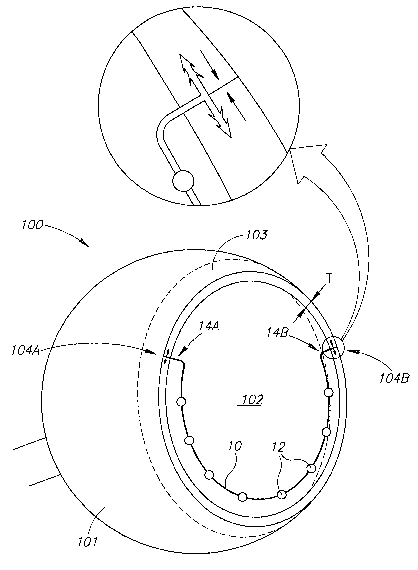Some of the information on this Web page has been provided by external sources. The Government of Canada is not responsible for the accuracy, reliability or currency of the information supplied by external sources. Users wishing to rely upon this information should consult directly with the source of the information. Content provided by external sources is not subject to official languages, privacy and accessibility requirements.
Any discrepancies in the text and image of the Claims and Abstract are due to differing posting times. Text of the Claims and Abstract are posted:
| (12) Patent Application: | (11) CA 2636068 |
|---|---|
| (54) English Title: | INTRAOCULAR DRUG DISPENSER |
| (54) French Title: | DISTRIBUTEUR DE MEDICAMENT INTRAOCULAIRE |
| Status: | Deemed Abandoned and Beyond the Period of Reinstatement - Pending Response to Notice of Disregarded Communication |
| (51) International Patent Classification (IPC): |
|
|---|---|
| (72) Inventors : |
|
| (73) Owners : |
|
| (71) Applicants : |
|
| (74) Agent: | INTEGRAL IP |
| (74) Associate agent: | |
| (45) Issued: | |
| (86) PCT Filing Date: | 2007-01-04 |
| (87) Open to Public Inspection: | 2007-07-26 |
| Availability of licence: | N/A |
| Dedicated to the Public: | N/A |
| (25) Language of filing: | English |
| Patent Cooperation Treaty (PCT): | Yes |
|---|---|
| (86) PCT Filing Number: | PCT/IL2007/000007 |
| (87) International Publication Number: | WO 2007083293 |
| (85) National Entry: | 2008-07-02 |
| (30) Application Priority Data: | ||||||
|---|---|---|---|---|---|---|
|
Intraocular drug dispenser including an elongated support member with a pair
of opposite ends for anchoring to opposite surfaces of an eye's eye wall, and
a string of discrete drug containing capsules for individual time controlled
release of their drug contents into an eye's vitreous cavity.
L~invention concerne un distributeur de médicament intraoculaire qui consiste en un élément de support allongé avec une paire d'extrémités opposées pouvant s~ancrer à des surfaces opposées d~une paroi oculaire d'un AEil, et un chapelet de capsules individuelles contenant un médicament pour libération individuelle contrôlée dans le temps de leur contenu médicamenteux dans la cavité vitreuse d'un AEil.
Note: Claims are shown in the official language in which they were submitted.
Note: Descriptions are shown in the official language in which they were submitted.

2024-08-01:As part of the Next Generation Patents (NGP) transition, the Canadian Patents Database (CPD) now contains a more detailed Event History, which replicates the Event Log of our new back-office solution.
Please note that "Inactive:" events refers to events no longer in use in our new back-office solution.
For a clearer understanding of the status of the application/patent presented on this page, the site Disclaimer , as well as the definitions for Patent , Event History , Maintenance Fee and Payment History should be consulted.
| Description | Date |
|---|---|
| Application Not Reinstated by Deadline | 2013-01-04 |
| Time Limit for Reversal Expired | 2013-01-04 |
| Deemed Abandoned - Failure to Respond to Maintenance Fee Notice | 2012-01-04 |
| Inactive: Abandon-RFE+Late fee unpaid-Correspondence sent | 2012-01-04 |
| Appointment of Agent Requirements Determined Compliant | 2008-12-04 |
| Inactive: Office letter | 2008-12-04 |
| Revocation of Agent Requirements Determined Compliant | 2008-12-04 |
| Letter Sent | 2008-12-02 |
| Inactive: Cover page published | 2008-11-05 |
| Inactive: Notice - National entry - No RFE | 2008-11-03 |
| Inactive: First IPC assigned | 2008-08-21 |
| Application Received - PCT | 2008-08-20 |
| Inactive: Single transfer | 2008-07-17 |
| Appointment of Agent Request | 2008-07-14 |
| Revocation of Agent Request | 2008-07-14 |
| National Entry Requirements Determined Compliant | 2008-07-02 |
| Application Published (Open to Public Inspection) | 2007-07-26 |
| Abandonment Date | Reason | Reinstatement Date |
|---|---|---|
| 2012-01-04 |
The last payment was received on 2010-12-10
Note : If the full payment has not been received on or before the date indicated, a further fee may be required which may be one of the following
Please refer to the CIPO Patent Fees web page to see all current fee amounts.
| Fee Type | Anniversary Year | Due Date | Paid Date |
|---|---|---|---|
| MF (application, 2nd anniv.) - standard | 02 | 2009-01-05 | 2008-07-02 |
| Basic national fee - standard | 2008-07-02 | ||
| Registration of a document | 2008-07-17 | ||
| MF (application, 3rd anniv.) - standard | 03 | 2010-01-04 | 2009-12-15 |
| MF (application, 4th anniv.) - standard | 04 | 2011-01-04 | 2010-12-10 |
Note: Records showing the ownership history in alphabetical order.
| Current Owners on Record |
|---|
| NULENS LTD |
| Past Owners on Record |
|---|
| JOSHUA BEN NUN |